Case Study: Panic Disorder with Agoraphobia
VerifiedAdded on 2023/01/07
|8
|2472
|52
AI Summary
This case study focuses on a patient named Dave who is suffering from panic disorder with agoraphobia. The study provides background information, a bio psychosocial formulation, diagnosis according to DSM-5, treatment modality (CBT), treatment plan, and recommendations. It also discusses the use of psychometrics instruments and the importance of following the DSM-5 criterion for accurate diagnosis.
Contribute Materials
Your contribution can guide someone’s learning journey. Share your
documents today.

Case Study
Secure Best Marks with AI Grader
Need help grading? Try our AI Grader for instant feedback on your assignments.
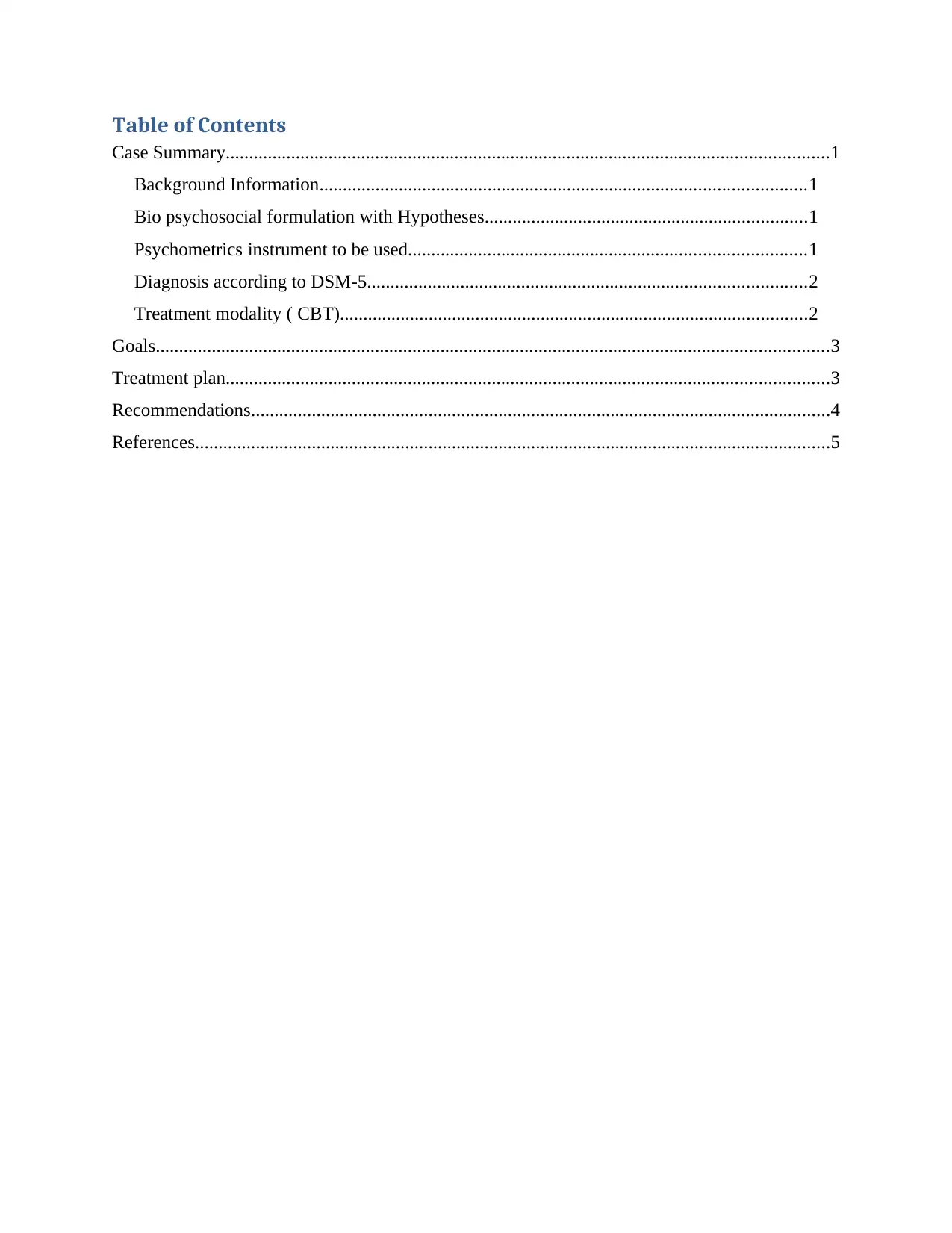
Table of Contents
Case Summary.................................................................................................................................1
Background Information........................................................................................................1
Bio psychosocial formulation with Hypotheses.....................................................................1
Psychometrics instrument to be used.....................................................................................1
Diagnosis according to DSM-5..............................................................................................2
Treatment modality ( CBT)....................................................................................................2
Goals................................................................................................................................................3
Treatment plan.................................................................................................................................3
Recommendations............................................................................................................................4
References........................................................................................................................................5
Case Summary.................................................................................................................................1
Background Information........................................................................................................1
Bio psychosocial formulation with Hypotheses.....................................................................1
Psychometrics instrument to be used.....................................................................................1
Diagnosis according to DSM-5..............................................................................................2
Treatment modality ( CBT)....................................................................................................2
Goals................................................................................................................................................3
Treatment plan.................................................................................................................................3
Recommendations............................................................................................................................4
References........................................................................................................................................5
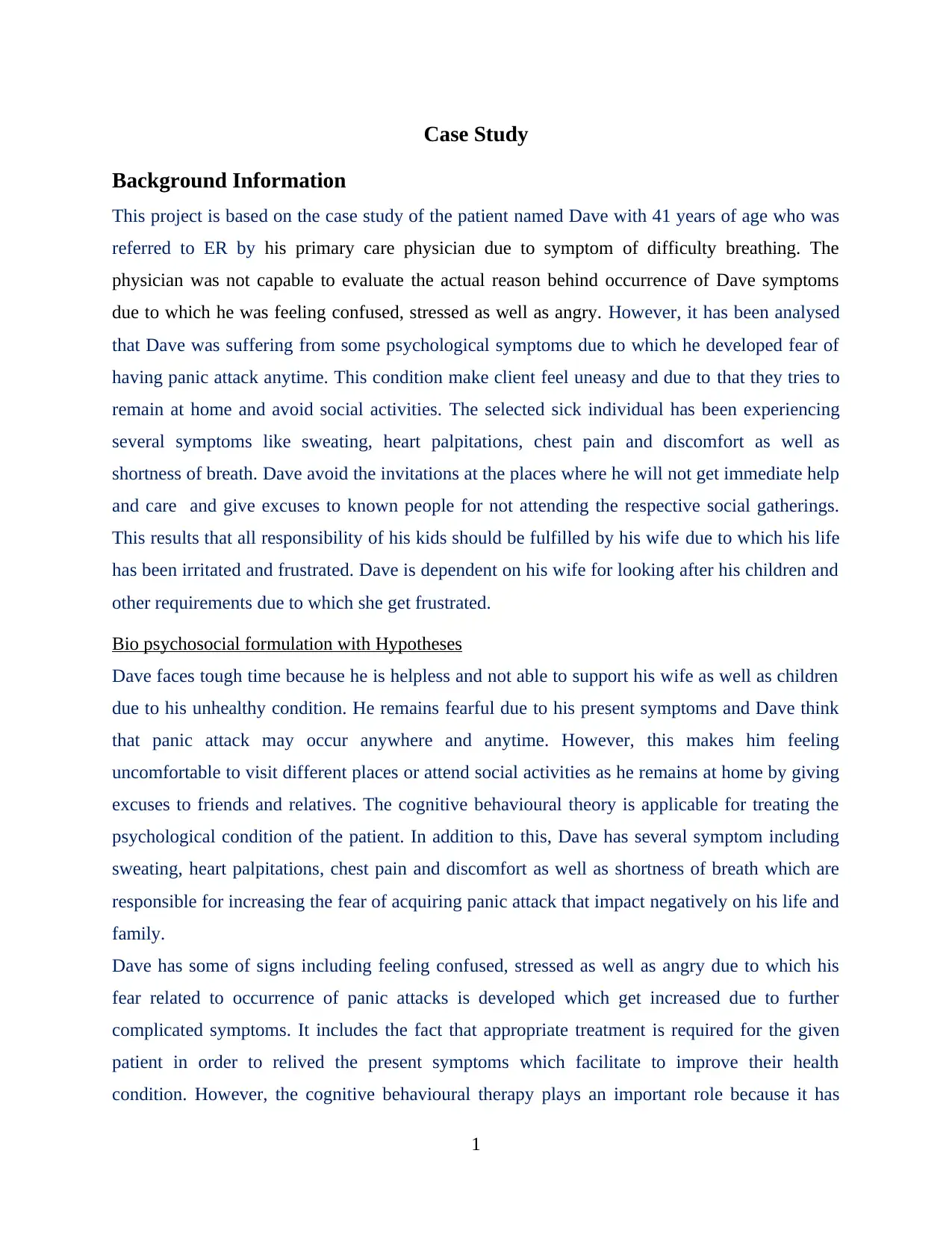
Case Study
Background Information
This project is based on the case study of the patient named Dave with 41 years of age who was
referred to ER by his primary care physician due to symptom of difficulty breathing. The
physician was not capable to evaluate the actual reason behind occurrence of Dave symptoms
due to which he was feeling confused, stressed as well as angry. However, it has been analysed
that Dave was suffering from some psychological symptoms due to which he developed fear of
having panic attack anytime. This condition make client feel uneasy and due to that they tries to
remain at home and avoid social activities. The selected sick individual has been experiencing
several symptoms like sweating, heart palpitations, chest pain and discomfort as well as
shortness of breath. Dave avoid the invitations at the places where he will not get immediate help
and care and give excuses to known people for not attending the respective social gatherings.
This results that all responsibility of his kids should be fulfilled by his wife due to which his life
has been irritated and frustrated. Dave is dependent on his wife for looking after his children and
other requirements due to which she get frustrated.
Bio psychosocial formulation with Hypotheses
Dave faces tough time because he is helpless and not able to support his wife as well as children
due to his unhealthy condition. He remains fearful due to his present symptoms and Dave think
that panic attack may occur anywhere and anytime. However, this makes him feeling
uncomfortable to visit different places or attend social activities as he remains at home by giving
excuses to friends and relatives. The cognitive behavioural theory is applicable for treating the
psychological condition of the patient. In addition to this, Dave has several symptom including
sweating, heart palpitations, chest pain and discomfort as well as shortness of breath which are
responsible for increasing the fear of acquiring panic attack that impact negatively on his life and
family.
Dave has some of signs including feeling confused, stressed as well as angry due to which his
fear related to occurrence of panic attacks is developed which get increased due to further
complicated symptoms. It includes the fact that appropriate treatment is required for the given
patient in order to relived the present symptoms which facilitate to improve their health
condition. However, the cognitive behavioural therapy plays an important role because it has
1
Background Information
This project is based on the case study of the patient named Dave with 41 years of age who was
referred to ER by his primary care physician due to symptom of difficulty breathing. The
physician was not capable to evaluate the actual reason behind occurrence of Dave symptoms
due to which he was feeling confused, stressed as well as angry. However, it has been analysed
that Dave was suffering from some psychological symptoms due to which he developed fear of
having panic attack anytime. This condition make client feel uneasy and due to that they tries to
remain at home and avoid social activities. The selected sick individual has been experiencing
several symptoms like sweating, heart palpitations, chest pain and discomfort as well as
shortness of breath. Dave avoid the invitations at the places where he will not get immediate help
and care and give excuses to known people for not attending the respective social gatherings.
This results that all responsibility of his kids should be fulfilled by his wife due to which his life
has been irritated and frustrated. Dave is dependent on his wife for looking after his children and
other requirements due to which she get frustrated.
Bio psychosocial formulation with Hypotheses
Dave faces tough time because he is helpless and not able to support his wife as well as children
due to his unhealthy condition. He remains fearful due to his present symptoms and Dave think
that panic attack may occur anywhere and anytime. However, this makes him feeling
uncomfortable to visit different places or attend social activities as he remains at home by giving
excuses to friends and relatives. The cognitive behavioural theory is applicable for treating the
psychological condition of the patient. In addition to this, Dave has several symptom including
sweating, heart palpitations, chest pain and discomfort as well as shortness of breath which are
responsible for increasing the fear of acquiring panic attack that impact negatively on his life and
family.
Dave has some of signs including feeling confused, stressed as well as angry due to which his
fear related to occurrence of panic attacks is developed which get increased due to further
complicated symptoms. It includes the fact that appropriate treatment is required for the given
patient in order to relived the present symptoms which facilitate to improve their health
condition. However, the cognitive behavioural therapy plays an important role because it has
1
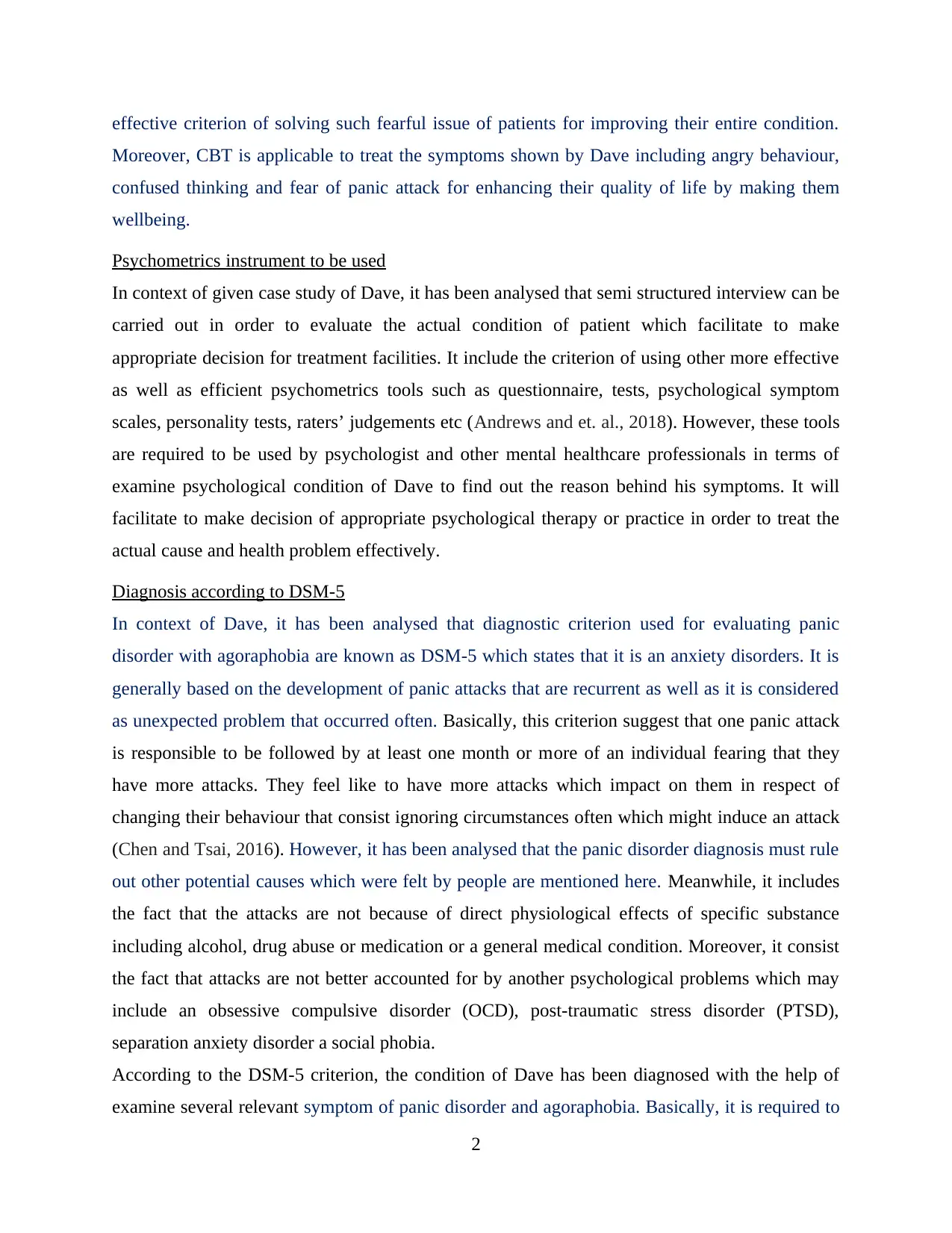
effective criterion of solving such fearful issue of patients for improving their entire condition.
Moreover, CBT is applicable to treat the symptoms shown by Dave including angry behaviour,
confused thinking and fear of panic attack for enhancing their quality of life by making them
wellbeing.
Psychometrics instrument to be used
In context of given case study of Dave, it has been analysed that semi structured interview can be
carried out in order to evaluate the actual condition of patient which facilitate to make
appropriate decision for treatment facilities. It include the criterion of using other more effective
as well as efficient psychometrics tools such as questionnaire, tests, psychological symptom
scales, personality tests, raters’ judgements etc (Andrews and et. al., 2018). However, these tools
are required to be used by psychologist and other mental healthcare professionals in terms of
examine psychological condition of Dave to find out the reason behind his symptoms. It will
facilitate to make decision of appropriate psychological therapy or practice in order to treat the
actual cause and health problem effectively.
Diagnosis according to DSM-5
In context of Dave, it has been analysed that diagnostic criterion used for evaluating panic
disorder with agoraphobia are known as DSM-5 which states that it is an anxiety disorders. It is
generally based on the development of panic attacks that are recurrent as well as it is considered
as unexpected problem that occurred often. Basically, this criterion suggest that one panic attack
is responsible to be followed by at least one month or more of an individual fearing that they
have more attacks. They feel like to have more attacks which impact on them in respect of
changing their behaviour that consist ignoring circumstances often which might induce an attack
(Chen and Tsai, 2016). However, it has been analysed that the panic disorder diagnosis must rule
out other potential causes which were felt by people are mentioned here. Meanwhile, it includes
the fact that the attacks are not because of direct physiological effects of specific substance
including alcohol, drug abuse or medication or a general medical condition. Moreover, it consist
the fact that attacks are not better accounted for by another psychological problems which may
include an obsessive compulsive disorder (OCD), post-traumatic stress disorder (PTSD),
separation anxiety disorder a social phobia.
According to the DSM-5 criterion, the condition of Dave has been diagnosed with the help of
examine several relevant symptom of panic disorder and agoraphobia. Basically, it is required to
2
Moreover, CBT is applicable to treat the symptoms shown by Dave including angry behaviour,
confused thinking and fear of panic attack for enhancing their quality of life by making them
wellbeing.
Psychometrics instrument to be used
In context of given case study of Dave, it has been analysed that semi structured interview can be
carried out in order to evaluate the actual condition of patient which facilitate to make
appropriate decision for treatment facilities. It include the criterion of using other more effective
as well as efficient psychometrics tools such as questionnaire, tests, psychological symptom
scales, personality tests, raters’ judgements etc (Andrews and et. al., 2018). However, these tools
are required to be used by psychologist and other mental healthcare professionals in terms of
examine psychological condition of Dave to find out the reason behind his symptoms. It will
facilitate to make decision of appropriate psychological therapy or practice in order to treat the
actual cause and health problem effectively.
Diagnosis according to DSM-5
In context of Dave, it has been analysed that diagnostic criterion used for evaluating panic
disorder with agoraphobia are known as DSM-5 which states that it is an anxiety disorders. It is
generally based on the development of panic attacks that are recurrent as well as it is considered
as unexpected problem that occurred often. Basically, this criterion suggest that one panic attack
is responsible to be followed by at least one month or more of an individual fearing that they
have more attacks. They feel like to have more attacks which impact on them in respect of
changing their behaviour that consist ignoring circumstances often which might induce an attack
(Chen and Tsai, 2016). However, it has been analysed that the panic disorder diagnosis must rule
out other potential causes which were felt by people are mentioned here. Meanwhile, it includes
the fact that the attacks are not because of direct physiological effects of specific substance
including alcohol, drug abuse or medication or a general medical condition. Moreover, it consist
the fact that attacks are not better accounted for by another psychological problems which may
include an obsessive compulsive disorder (OCD), post-traumatic stress disorder (PTSD),
separation anxiety disorder a social phobia.
According to the DSM-5 criterion, the condition of Dave has been diagnosed with the help of
examine several relevant symptom of panic disorder and agoraphobia. Basically, it is required to
2
Secure Best Marks with AI Grader
Need help grading? Try our AI Grader for instant feedback on your assignments.
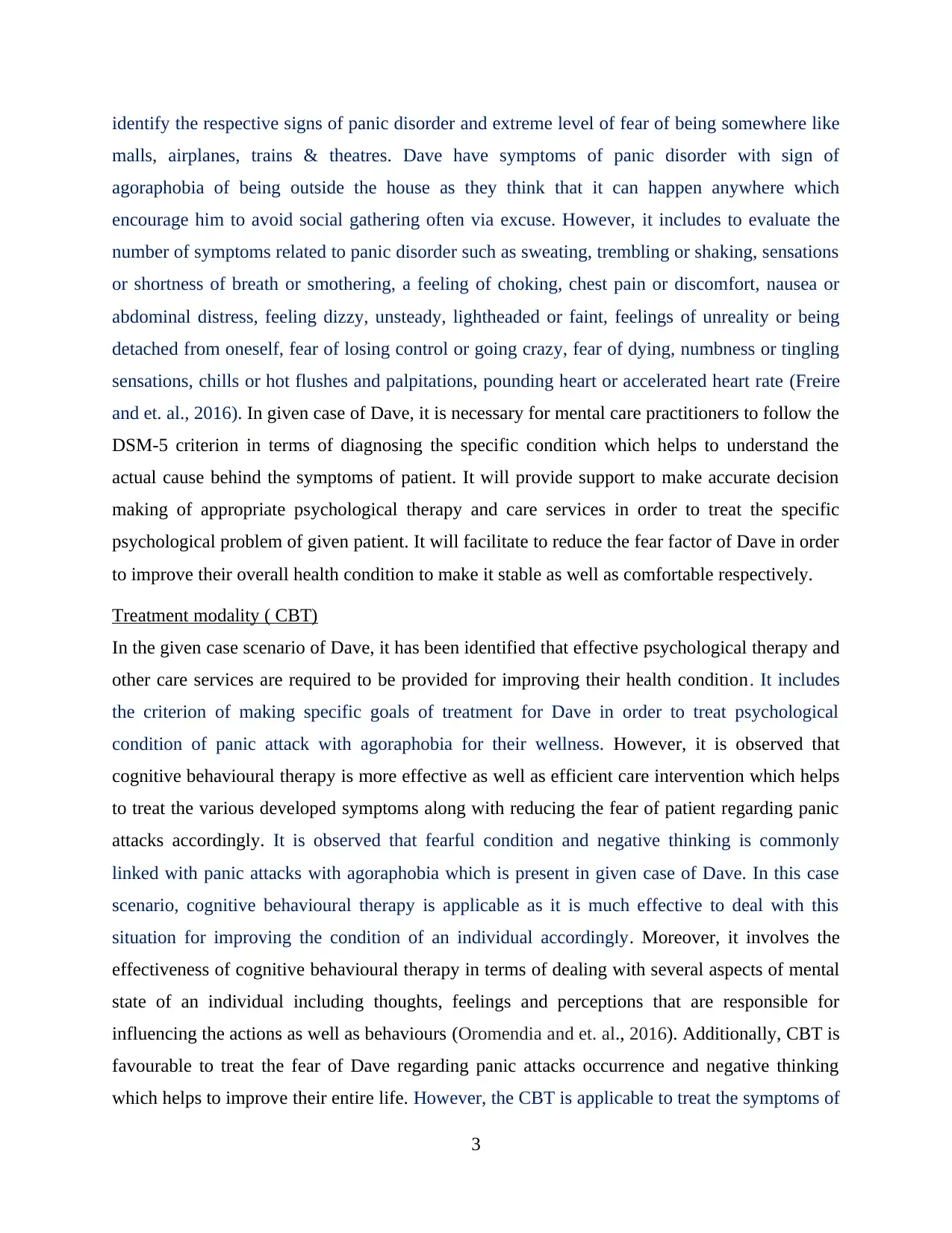
identify the respective signs of panic disorder and extreme level of fear of being somewhere like
malls, airplanes, trains & theatres. Dave have symptoms of panic disorder with sign of
agoraphobia of being outside the house as they think that it can happen anywhere which
encourage him to avoid social gathering often via excuse. However, it includes to evaluate the
number of symptoms related to panic disorder such as sweating, trembling or shaking, sensations
or shortness of breath or smothering, a feeling of choking, chest pain or discomfort, nausea or
abdominal distress, feeling dizzy, unsteady, lightheaded or faint, feelings of unreality or being
detached from oneself, fear of losing control or going crazy, fear of dying, numbness or tingling
sensations, chills or hot flushes and palpitations, pounding heart or accelerated heart rate (Freire
and et. al., 2016). In given case of Dave, it is necessary for mental care practitioners to follow the
DSM-5 criterion in terms of diagnosing the specific condition which helps to understand the
actual cause behind the symptoms of patient. It will provide support to make accurate decision
making of appropriate psychological therapy and care services in order to treat the specific
psychological problem of given patient. It will facilitate to reduce the fear factor of Dave in order
to improve their overall health condition to make it stable as well as comfortable respectively.
Treatment modality ( CBT)
In the given case scenario of Dave, it has been identified that effective psychological therapy and
other care services are required to be provided for improving their health condition. It includes
the criterion of making specific goals of treatment for Dave in order to treat psychological
condition of panic attack with agoraphobia for their wellness. However, it is observed that
cognitive behavioural therapy is more effective as well as efficient care intervention which helps
to treat the various developed symptoms along with reducing the fear of patient regarding panic
attacks accordingly. It is observed that fearful condition and negative thinking is commonly
linked with panic attacks with agoraphobia which is present in given case of Dave. In this case
scenario, cognitive behavioural therapy is applicable as it is much effective to deal with this
situation for improving the condition of an individual accordingly. Moreover, it involves the
effectiveness of cognitive behavioural therapy in terms of dealing with several aspects of mental
state of an individual including thoughts, feelings and perceptions that are responsible for
influencing the actions as well as behaviours (Oromendia and et. al., 2016). Additionally, CBT is
favourable to treat the fear of Dave regarding panic attacks occurrence and negative thinking
which helps to improve their entire life. However, the CBT is applicable to treat the symptoms of
3
malls, airplanes, trains & theatres. Dave have symptoms of panic disorder with sign of
agoraphobia of being outside the house as they think that it can happen anywhere which
encourage him to avoid social gathering often via excuse. However, it includes to evaluate the
number of symptoms related to panic disorder such as sweating, trembling or shaking, sensations
or shortness of breath or smothering, a feeling of choking, chest pain or discomfort, nausea or
abdominal distress, feeling dizzy, unsteady, lightheaded or faint, feelings of unreality or being
detached from oneself, fear of losing control or going crazy, fear of dying, numbness or tingling
sensations, chills or hot flushes and palpitations, pounding heart or accelerated heart rate (Freire
and et. al., 2016). In given case of Dave, it is necessary for mental care practitioners to follow the
DSM-5 criterion in terms of diagnosing the specific condition which helps to understand the
actual cause behind the symptoms of patient. It will provide support to make accurate decision
making of appropriate psychological therapy and care services in order to treat the specific
psychological problem of given patient. It will facilitate to reduce the fear factor of Dave in order
to improve their overall health condition to make it stable as well as comfortable respectively.
Treatment modality ( CBT)
In the given case scenario of Dave, it has been identified that effective psychological therapy and
other care services are required to be provided for improving their health condition. It includes
the criterion of making specific goals of treatment for Dave in order to treat psychological
condition of panic attack with agoraphobia for their wellness. However, it is observed that
cognitive behavioural therapy is more effective as well as efficient care intervention which helps
to treat the various developed symptoms along with reducing the fear of patient regarding panic
attacks accordingly. It is observed that fearful condition and negative thinking is commonly
linked with panic attacks with agoraphobia which is present in given case of Dave. In this case
scenario, cognitive behavioural therapy is applicable as it is much effective to deal with this
situation for improving the condition of an individual accordingly. Moreover, it involves the
effectiveness of cognitive behavioural therapy in terms of dealing with several aspects of mental
state of an individual including thoughts, feelings and perceptions that are responsible for
influencing the actions as well as behaviours (Oromendia and et. al., 2016). Additionally, CBT is
favourable to treat the fear of Dave regarding panic attacks occurrence and negative thinking
which helps to improve their entire life. However, the CBT is applicable to treat the symptoms of
3
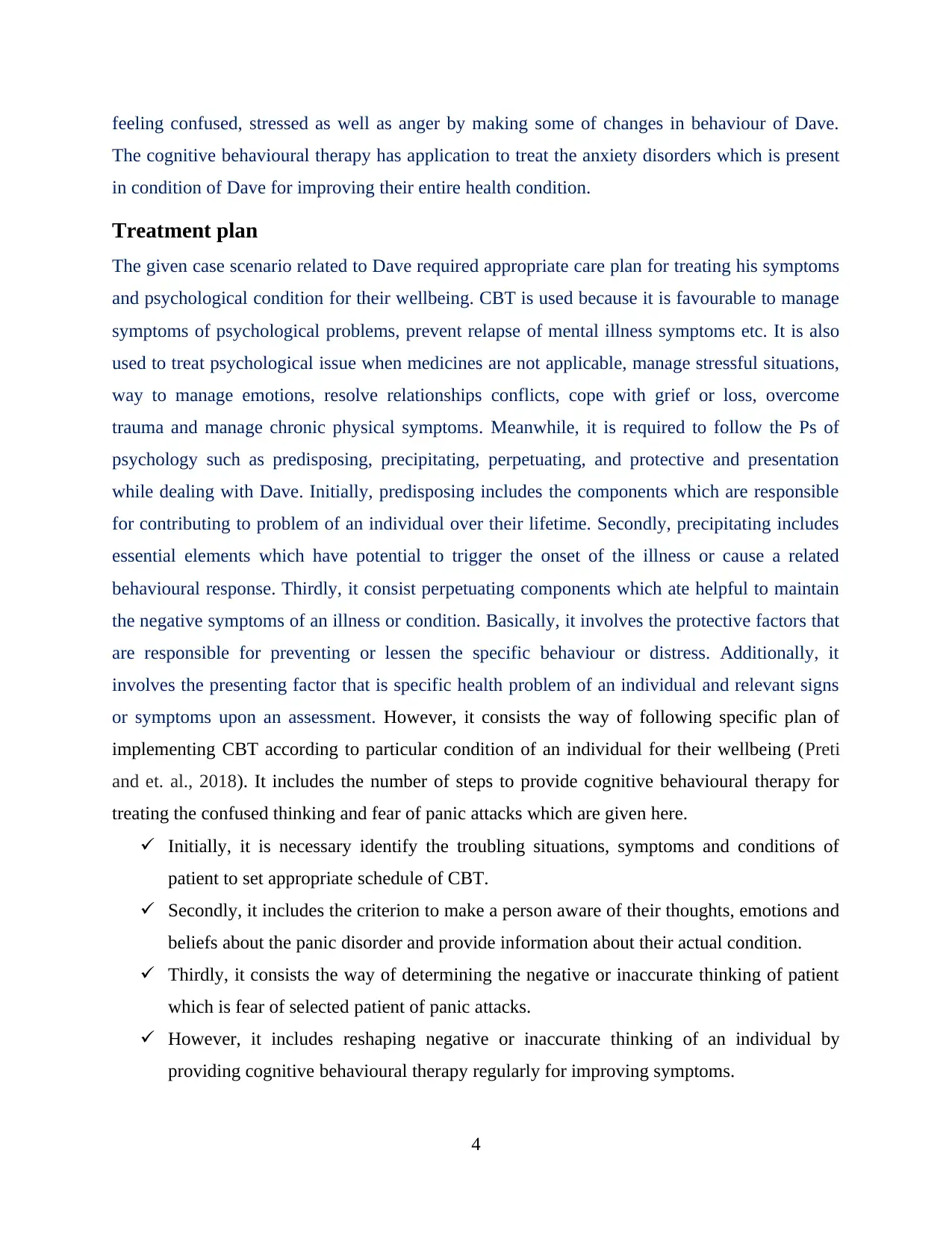
feeling confused, stressed as well as anger by making some of changes in behaviour of Dave.
The cognitive behavioural therapy has application to treat the anxiety disorders which is present
in condition of Dave for improving their entire health condition.
Treatment plan
The given case scenario related to Dave required appropriate care plan for treating his symptoms
and psychological condition for their wellbeing. CBT is used because it is favourable to manage
symptoms of psychological problems, prevent relapse of mental illness symptoms etc. It is also
used to treat psychological issue when medicines are not applicable, manage stressful situations,
way to manage emotions, resolve relationships conflicts, cope with grief or loss, overcome
trauma and manage chronic physical symptoms. Meanwhile, it is required to follow the Ps of
psychology such as predisposing, precipitating, perpetuating, and protective and presentation
while dealing with Dave. Initially, predisposing includes the components which are responsible
for contributing to problem of an individual over their lifetime. Secondly, precipitating includes
essential elements which have potential to trigger the onset of the illness or cause a related
behavioural response. Thirdly, it consist perpetuating components which ate helpful to maintain
the negative symptoms of an illness or condition. Basically, it involves the protective factors that
are responsible for preventing or lessen the specific behaviour or distress. Additionally, it
involves the presenting factor that is specific health problem of an individual and relevant signs
or symptoms upon an assessment. However, it consists the way of following specific plan of
implementing CBT according to particular condition of an individual for their wellbeing (Preti
and et. al., 2018). It includes the number of steps to provide cognitive behavioural therapy for
treating the confused thinking and fear of panic attacks which are given here.
Initially, it is necessary identify the troubling situations, symptoms and conditions of
patient to set appropriate schedule of CBT.
Secondly, it includes the criterion to make a person aware of their thoughts, emotions and
beliefs about the panic disorder and provide information about their actual condition.
Thirdly, it consists the way of determining the negative or inaccurate thinking of patient
which is fear of selected patient of panic attacks.
However, it includes reshaping negative or inaccurate thinking of an individual by
providing cognitive behavioural therapy regularly for improving symptoms.
4
The cognitive behavioural therapy has application to treat the anxiety disorders which is present
in condition of Dave for improving their entire health condition.
Treatment plan
The given case scenario related to Dave required appropriate care plan for treating his symptoms
and psychological condition for their wellbeing. CBT is used because it is favourable to manage
symptoms of psychological problems, prevent relapse of mental illness symptoms etc. It is also
used to treat psychological issue when medicines are not applicable, manage stressful situations,
way to manage emotions, resolve relationships conflicts, cope with grief or loss, overcome
trauma and manage chronic physical symptoms. Meanwhile, it is required to follow the Ps of
psychology such as predisposing, precipitating, perpetuating, and protective and presentation
while dealing with Dave. Initially, predisposing includes the components which are responsible
for contributing to problem of an individual over their lifetime. Secondly, precipitating includes
essential elements which have potential to trigger the onset of the illness or cause a related
behavioural response. Thirdly, it consist perpetuating components which ate helpful to maintain
the negative symptoms of an illness or condition. Basically, it involves the protective factors that
are responsible for preventing or lessen the specific behaviour or distress. Additionally, it
involves the presenting factor that is specific health problem of an individual and relevant signs
or symptoms upon an assessment. However, it consists the way of following specific plan of
implementing CBT according to particular condition of an individual for their wellbeing (Preti
and et. al., 2018). It includes the number of steps to provide cognitive behavioural therapy for
treating the confused thinking and fear of panic attacks which are given here.
Initially, it is necessary identify the troubling situations, symptoms and conditions of
patient to set appropriate schedule of CBT.
Secondly, it includes the criterion to make a person aware of their thoughts, emotions and
beliefs about the panic disorder and provide information about their actual condition.
Thirdly, it consists the way of determining the negative or inaccurate thinking of patient
which is fear of selected patient of panic attacks.
However, it includes reshaping negative or inaccurate thinking of an individual by
providing cognitive behavioural therapy regularly for improving symptoms.
4
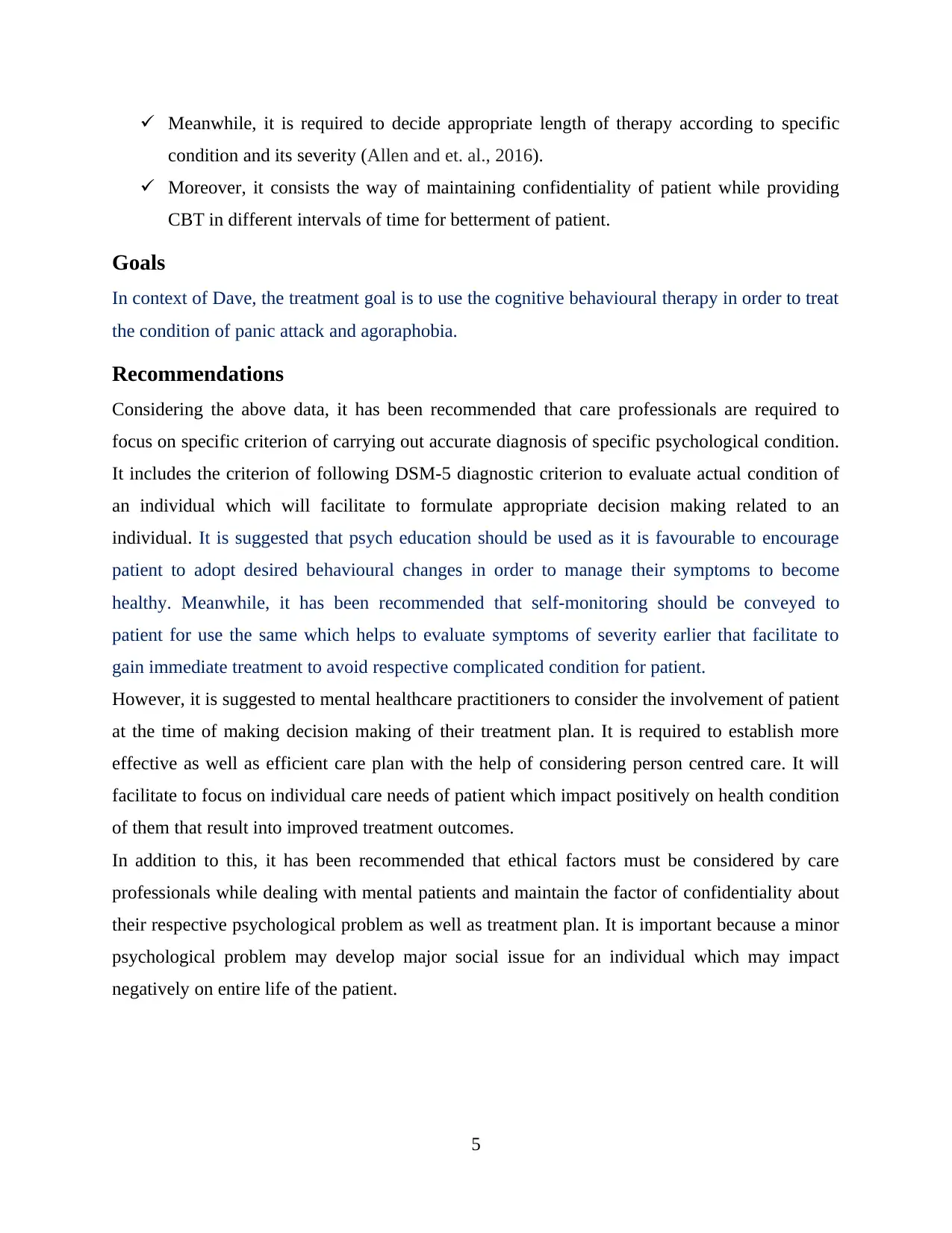
Meanwhile, it is required to decide appropriate length of therapy according to specific
condition and its severity (Allen and et. al., 2016).
Moreover, it consists the way of maintaining confidentiality of patient while providing
CBT in different intervals of time for betterment of patient.
Goals
In context of Dave, the treatment goal is to use the cognitive behavioural therapy in order to treat
the condition of panic attack and agoraphobia.
Recommendations
Considering the above data, it has been recommended that care professionals are required to
focus on specific criterion of carrying out accurate diagnosis of specific psychological condition.
It includes the criterion of following DSM-5 diagnostic criterion to evaluate actual condition of
an individual which will facilitate to formulate appropriate decision making related to an
individual. It is suggested that psych education should be used as it is favourable to encourage
patient to adopt desired behavioural changes in order to manage their symptoms to become
healthy. Meanwhile, it has been recommended that self-monitoring should be conveyed to
patient for use the same which helps to evaluate symptoms of severity earlier that facilitate to
gain immediate treatment to avoid respective complicated condition for patient.
However, it is suggested to mental healthcare practitioners to consider the involvement of patient
at the time of making decision making of their treatment plan. It is required to establish more
effective as well as efficient care plan with the help of considering person centred care. It will
facilitate to focus on individual care needs of patient which impact positively on health condition
of them that result into improved treatment outcomes.
In addition to this, it has been recommended that ethical factors must be considered by care
professionals while dealing with mental patients and maintain the factor of confidentiality about
their respective psychological problem as well as treatment plan. It is important because a minor
psychological problem may develop major social issue for an individual which may impact
negatively on entire life of the patient.
5
condition and its severity (Allen and et. al., 2016).
Moreover, it consists the way of maintaining confidentiality of patient while providing
CBT in different intervals of time for betterment of patient.
Goals
In context of Dave, the treatment goal is to use the cognitive behavioural therapy in order to treat
the condition of panic attack and agoraphobia.
Recommendations
Considering the above data, it has been recommended that care professionals are required to
focus on specific criterion of carrying out accurate diagnosis of specific psychological condition.
It includes the criterion of following DSM-5 diagnostic criterion to evaluate actual condition of
an individual which will facilitate to formulate appropriate decision making related to an
individual. It is suggested that psych education should be used as it is favourable to encourage
patient to adopt desired behavioural changes in order to manage their symptoms to become
healthy. Meanwhile, it has been recommended that self-monitoring should be conveyed to
patient for use the same which helps to evaluate symptoms of severity earlier that facilitate to
gain immediate treatment to avoid respective complicated condition for patient.
However, it is suggested to mental healthcare practitioners to consider the involvement of patient
at the time of making decision making of their treatment plan. It is required to establish more
effective as well as efficient care plan with the help of considering person centred care. It will
facilitate to focus on individual care needs of patient which impact positively on health condition
of them that result into improved treatment outcomes.
In addition to this, it has been recommended that ethical factors must be considered by care
professionals while dealing with mental patients and maintain the factor of confidentiality about
their respective psychological problem as well as treatment plan. It is important because a minor
psychological problem may develop major social issue for an individual which may impact
negatively on entire life of the patient.
5
Paraphrase This Document
Need a fresh take? Get an instant paraphrase of this document with our AI Paraphraser
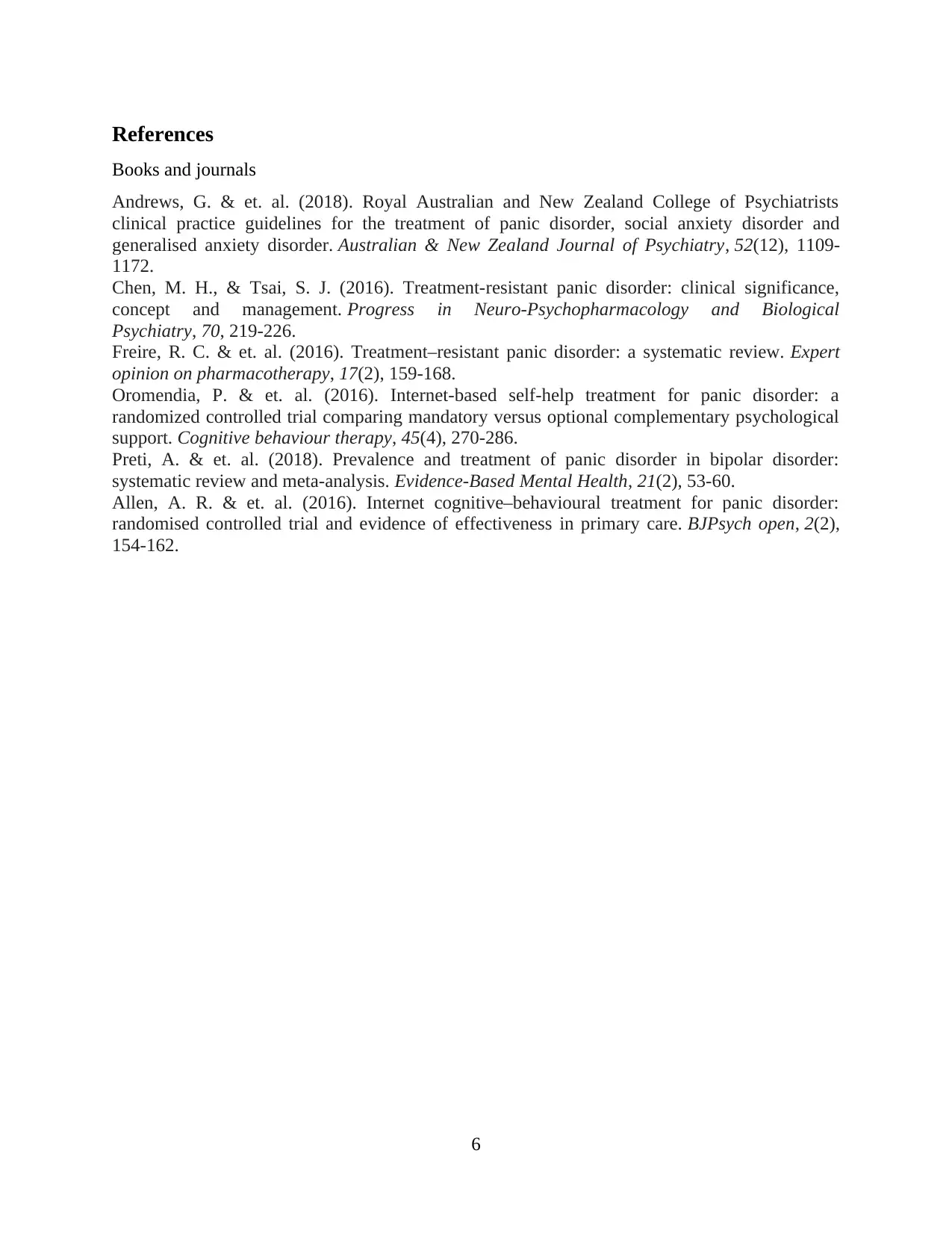
References
Books and journals
Andrews, G. & et. al. (2018). Royal Australian and New Zealand College of Psychiatrists
clinical practice guidelines for the treatment of panic disorder, social anxiety disorder and
generalised anxiety disorder. Australian & New Zealand Journal of Psychiatry, 52(12), 1109-
1172.
Chen, M. H., & Tsai, S. J. (2016). Treatment-resistant panic disorder: clinical significance,
concept and management. Progress in Neuro-Psychopharmacology and Biological
Psychiatry, 70, 219-226.
Freire, R. C. & et. al. (2016). Treatment–resistant panic disorder: a systematic review. Expert
opinion on pharmacotherapy, 17(2), 159-168.
Oromendia, P. & et. al. (2016). Internet-based self-help treatment for panic disorder: a
randomized controlled trial comparing mandatory versus optional complementary psychological
support. Cognitive behaviour therapy, 45(4), 270-286.
Preti, A. & et. al. (2018). Prevalence and treatment of panic disorder in bipolar disorder:
systematic review and meta-analysis. Evidence-Based Mental Health, 21(2), 53-60.
Allen, A. R. & et. al. (2016). Internet cognitive–behavioural treatment for panic disorder:
randomised controlled trial and evidence of effectiveness in primary care. BJPsych open, 2(2),
154-162.
6
Books and journals
Andrews, G. & et. al. (2018). Royal Australian and New Zealand College of Psychiatrists
clinical practice guidelines for the treatment of panic disorder, social anxiety disorder and
generalised anxiety disorder. Australian & New Zealand Journal of Psychiatry, 52(12), 1109-
1172.
Chen, M. H., & Tsai, S. J. (2016). Treatment-resistant panic disorder: clinical significance,
concept and management. Progress in Neuro-Psychopharmacology and Biological
Psychiatry, 70, 219-226.
Freire, R. C. & et. al. (2016). Treatment–resistant panic disorder: a systematic review. Expert
opinion on pharmacotherapy, 17(2), 159-168.
Oromendia, P. & et. al. (2016). Internet-based self-help treatment for panic disorder: a
randomized controlled trial comparing mandatory versus optional complementary psychological
support. Cognitive behaviour therapy, 45(4), 270-286.
Preti, A. & et. al. (2018). Prevalence and treatment of panic disorder in bipolar disorder:
systematic review and meta-analysis. Evidence-Based Mental Health, 21(2), 53-60.
Allen, A. R. & et. al. (2016). Internet cognitive–behavioural treatment for panic disorder:
randomised controlled trial and evidence of effectiveness in primary care. BJPsych open, 2(2),
154-162.
6
1 out of 8
Related Documents
Your All-in-One AI-Powered Toolkit for Academic Success.
+13062052269
info@desklib.com
Available 24*7 on WhatsApp / Email
![[object Object]](/_next/static/media/star-bottom.7253800d.svg)
Unlock your academic potential
© 2024 | Zucol Services PVT LTD | All rights reserved.





